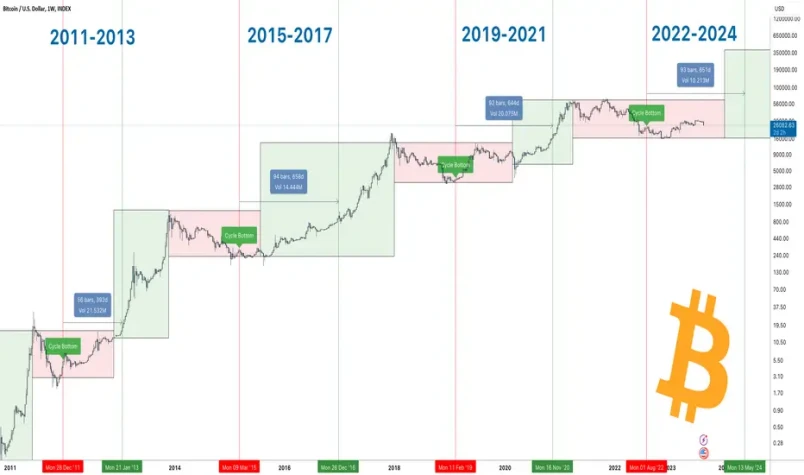1. BTC spot ETF is expected to be launched in 2024
In January 2024, the cryptocurrency market will usher in an important decision by the U.S. Securities and Exchange Commission (SEC) on multiple BTC spot ETF applications. It is well known that BTC spot ETFs allow investors to invest in BTC without the complexities of direct ownership, which is very attractive to institutional investors. Anticipation of the approval of a BTC spot ETF is likely to expand BTC’s investor base, thereby increasing its adoption and price stability. Investment management firm Vaneck estimates that potential institutional investment will exceed $2.4 billion, which would drive Bitcoins price higher.
Multiple industry analysts and crypto executives predict that BTC will reach or even exceed $100,000 following the passage of a BTC spot ETF. For example, Bitwise predicts that BTC will reach $80,000 in 2024, driven by spot ETFs, and Matrixport and Standard Chartered believe that BTC will break the $100,000 mark. However, some institutions are not optimistic about this. For example, JP Morgan believes that the benefits of ETFs have been partially realized at the current price, and the subsequent upward momentum will not be sufficient.
2. Interest rate cuts promote the revival of the crypto market
The macroeconomic environment in 2024 will be more favorable for the development of the cryptocurrency industry, with global central banks abandoning expectations of further interest rate hikes, which may increase the price of speculative assets such as cryptocurrencies. According to current consensus forecasts, most major central banks will lower policy rates driven by falling inflation, a shift aimed at moving policy rates from restraint to neutral levels. Both the Federal Reserve and the European Central Bank are expected to start lowering interest rates in mid-2024, according to BofA Global Research. Lower interest rates typically make traditional safe-haven assets less attractive, making high-risk, high-return assets like cryptocurrencies more attractive to investors. At the same time, lower borrowing costs can also promote more investment in the cryptocurrency industry, thereby pushing up the price of cryptocurrency.
3. The halving of BTC production has become a bull market catalyst
In addition to BTC spot ETFs and a positive macroeconomic environment, the upcoming BTC production halving could serve as a catalyst for a bull run. BTC is expected to undergo a production halving between April or May 2024, reducing miners’ block rewards from 6.25 BTC to 3.125 BTC. Historically, this will impact the supply and demand dynamics of BTC, with significant implications for the BTC network.

Halving production can reduce the rate at which newly produced BTC flows into the market, thereby reducing the liquidity supply of BTC. Past halving cycles have led to increases in BTC prices, especially early on. For example, after the first halving in 2012, the price of BTC rose from $12 to $964 in 1 year. The production halvings in 2016 and 2020 also resulted in significant increases in BTC prices. Although the impact of the 2024 production halving is difficult to predict, historical trends indicate that it will have a positive impact on the price of BTC, which, coupled with spot ETF hype and macroeconomic factors, may once again spawn a trending bull market.
4. The crypto market may usher in a copycat season
As mentioned earlier, expectations for the passage of BTC spot ETFs and expectations for interest rate cuts from global central banks may create a favorable environment for the cryptocurrency market. After the bull run in BTC and ETH reaches a certain point, investors’ attention will shift to altcoins. This could lead to a copycat season, causing projects with currently smaller market caps to see larger gains. The next major alt season could happen before May 2024, as investors seek to diversify their portfolios and take advantage of emerging opportunities in the broader cryptocurrency market, according to cryptocurrency trader Crypto Feras.
5. With the introduction of new regulations, the FTX and Celsius incidents have been resolved
The FTX and Celsius bankruptcies, which devastated the crypto industry in 2022 and early 2023 and prompted major regulatory crypto litigation around the world, are expected to be resolved in 2024, as governments are seriously addressing cryptocurrency regulations around the world. FTX is considering a relaunch in 2024, according to a proposed plan by FTX’s bankruptcy administrator. The plan is to relaunch FTX.com primarily for offshore customers, not those in the United States. The proposal includes organizing creditors into different classes, with specific classes having the option of partnering with third-party investors to set up offshore trading companies or relaunch platforms. The restart plan requires agreement among various stakeholders and court approval.
Crypto lending platform Celsius filed for bankruptcy in July 2022 after the company misused customer funds. Now, Celsius has been approved by the U.S. Bankruptcy Court for a reorganization plan to emerge from bankruptcy that involves returning cryptocurrencies to customers and creating a new company managed by Fahrenheit LLC. The reorganized operation will focus on BTC mining and earning staking fees. The program is expected to be implemented in early 2024.
6. U.S. Encryption Act Launched
In 2023, a U.S. congressional committee proposed a bipartisan bill to establish a regulatory framework for cryptocurrencies, marking a major step toward regulation for the crypto-asset industry. The bill seeks to clarify when cryptocurrencies should be deemed securities or commodities, resolving key ambiguities in current regulations. The bill proposes to expand the U.S. Commodity Futures Trading Commission’s (CFTC) oversight of cryptocurrencies while also defining the U.S. Securities and Exchange Commission’s (SEC) jurisdiction.
There is currently some dispute over the scope of cryptocurrency regulation between the SEC and CFTC, with both seeking to assert their regulatory authority over different aspects of the crypto market. These controversies reflect the existing confusion and lack of clear regulatory boundaries in the crypto market. Its unclear whether the bill can be passed by the Senate. While the bill has the support of industry stakeholders and some politicians, it also faces some opposition over concerns it could weaken consumer protections.
7. European MiCA redefines encryption regulations
While the United States is working towards a unified regulatory framework for cryptocurrencies, Europe has already addressed the issue. The Markets in Crypto-Assets Regulation (MiCA), which will come into force in 2024, will establish a comprehensive framework for cryptocurrencies. The comprehensive regulation, the first of its kind in a major jurisdiction, requires the registration of providers of crypto wallets and trading platforms within the EU, and requires stablecoin issuers to maintain adequate reserves. Additionally, the funds transfer regulations will work with MiCA to enhance anti-money laundering measures by requiring cryptocurrency operators to identify their customers.
8. Decentralized blockchain facilities will grow rapidly
Incidents such as FTX, Celsius and others have eroded market participants’ trust in centralized cryptocurrency platforms. Because of this, DEX and DeFi have great opportunities for development in 2023. And, as they align with the original value of cryptocurrencies, greater decentralization trends will continue in 2024. Decentralized technology and the crypto industry will continue to undergo transformative changes in 2024. The DeFi sector is leading this change, expanding its product offerings to include more complex financial services, including loans, lending, and insurance, increasing the scope and accessibility of DeFi solutions.
DEXs offer market participants a more secure and transparent alternative to risk-laden centralized platforms and are growing rapidly. The growth of DEX is stimulated by advancements in various fields: firstly, major improvements include enhanced liquidity solutions, which solve the long-standing problem of limited liquidity of DEX, which has always been an important advantage of centralized platforms; secondly, DEX Simplifying the interface to appeal to a wider, less tech-savvy audience with a better user experience; Third, DEX is implementing a 2-tier solution to increase scalability and transaction speed while reducing costs; Finally, introducing complex trading features (such as derivatives trading) are enabling DEXs to provide services that were once only available at CEXs.
NFTs have already had a significant impact on areas such as art, music, and games, and by 2024, the integration of NFTs and other areas is expected to deepen. The potential applications of NFTs are wide ranging, from digital asset ownership to authentication of physical items. This trend will redefine ownership and authenticity in the digital age and provide more opportunities for creators.
In 2024, interoperability of blockchain networks is expected to gain momentum, and we may see a significant increase in blockchain projects that prioritize cross-chain compatibility. This interoperability will enable greater collaboration between various blockchain ecosystems. Additionally, with global awareness of environmental issues, sustainability is becoming a key focus for blockchain development. It is expected that many blockchain projects will adopt more energy-efficient consensus mechanisms in an effort to reduce the environmental impact of blockchain technology.
summary
2024 will see some major developments in the cryptocurrency industry worth watching, along with a potential bull run. Resolution of key cases like FTX and Celsius and regulatory clarity will help build mainstream society’s trust in the cryptocurrency industry. In addition, the development of DeFi and decentralized technologies will allow cryptocurrencies to enter a more decentralized path. Therefore, 2024 may be the turning point for mainstream adoption of cryptocurrencies.










